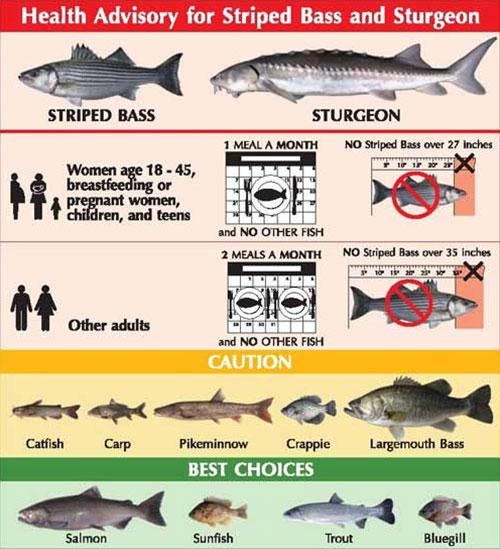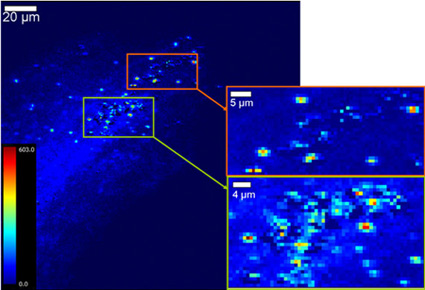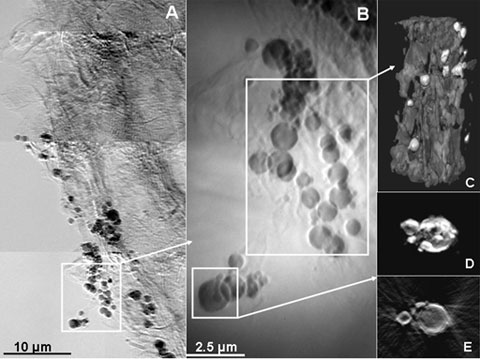

Mercury in the environment can easily reach toxic levels. In a process called
methylation, Hg is transformed into a form that can be accumulated in the
muscle and fatty tissue of fish. Accumulated levels of methylmercury become
higher as the fish grow, and levels are magnified up the food web as larger
fish eat smaller fish, a process called biomagnification. As a result, mercury
concentrations in fish can be millions of times higher than in surrounding
waters [1]. Fish advisories have been set to limit consumption
of certain fish higher up on the food web, especially for pregnant women and
small children (see Figure 1).
Figure 1.
Mercury health risks Health advisory from the CALFED Science Program to limit
consumption of fish, in order to avoid excessive accumulation of Hg.
Methylated Hg is biomagnified up the food chain, attaining high levels in some
types of sportfish.
http://science.calwater.ca.gov/images/scinews_hg_da_lg.jpg
The team collected S. foliosa and S. alterniflora plants from two
locations in SF Bay and studied their native Hg levels, as well as their
capacity for Hg uptake. Using Hg L3 XANES collected on Beam Lines
9-3 and 10-2 they determined the overall chemical speciation, or forms, of Hg
within the plants and their root zones. Scanning x-ray fluorescence (XRF) and
micro-XANES on Beam Line 2-3 were utilized to map the location, distribution,
Figure 2.
Microprobe map (SSRL BL2-3) of Hg fluorescence on logarithmic scale shows size
and distribution of Hg within micron-sized S. foliosa roots (A).
Micro-XANES points were selected from the highest concentration areas ("hot
spots", indicated red). Fluorescent counts (range 0-603) in insets (B and C)
were determined as a difference above the Hg edge (12300 eV), minus below
(12250 eV). (Figure adapted from Patty et al. 2009)
In summary, the use of X-ray microscopy combined with Hg L3 XANES
has permitted us to obtain a "snapshot" of mercury methylation and metacinnabar
precipitation in S. foliosa and S. alterniflora. This "snapshot"
of Hg methylation in progress provides insight into the spatial and biochemical
relationships between SRB and Spartina roots, revealing areas of Hg
concentration within both. Although we found that the native
S. foliosa has
the capability for greater Hg uptake, perhaps due to its longer adaptation to
the Hg-contaminated area; total Hg concentrations are the same in both species
in the field, indicating that there is no significant difference in the amount
of methylmercury that would be produced by each species. Although
concentrations in the field average 0.1 ppm for both Spartina species, these
are dominant florae within SF Bay and other locations. If an average of 10% of
this Hg is methylated, Spartina must be carefully considered for its role in
mercury methylation in the SF Bay estuarine ecosystem. This work has been
published in Environmental Science and Technology.
Primary Citation
Patty C, Barnett B, Mooney B, Kahn A, Levy S, Liu Y, Pianetta P, Andrews JC
(2009) Using X-ray Microscopy and Hg L3 XANES to study Hg Binding in
the Rhizosphere of Spartina Cordgrass. Environ Sci Technol 43:
7397-7402.
References
Acknowledgments
We thank Susan Opp for her help in statistical treatment of the Hg uptake data;
and Sam Webb, Sean Brennan, Jennifer Cassano, and Sarah Hayes for their help
with data collection. A. Kahn and B. Mooney were supported by awards from the
CSU East Bay Associated Students, and CSU East Bay provided support to J. C.
Andrews. SSRL is supported by the Department of Energy, Office of Basic Energy
Sciences. The transmission x-ray microscope is supported by NIH/NIBIB grant
number 5R01EB004321.
The SSRL Structural Molecular Biology Program is supported by the Department of
Energy, Office of Biological and Environmental Research, and by the National
Institutes of Health, National Center for Research Resources, Biomedical
Technology Program, and the National Institute of General Medical Sciences.
Plants and microorganisms in the ecosystem can play an important role in the
chemical transformation, including methylation, of mercury. In particular the
root zone, or rhizosphere, of plants is an important place where microorganisms
such as sulfate reducing bacteria (SRB) can transform Hg [2].
We studied Hg uptake and transformation in the rhizosphere of two species of
cordgrass that are prevalent in San Francisco Bay. One is the native species
that has an essential role in the ecosystem, including housing nests for
endangered species (Spartina foliosa), the other a hybrid of this native
with an invasive cordgrass species (Spartina alterniflora hybrid)
[3]. Because these are dominant plants within the SF Bay
ecosystem, understanding the chemical transformation of Hg in their root zone
can help scientists to characterize their roles in mercury biogeochemical
cycling in the estuarine environment, and possibly to determine ways to
remediate the problem.

and speciation of Hg within the plant roots, which appeared in concentrated
spots (Figure 2).

Using transmission x-ray microscopy (TXM) on Beam Line 6-2c, it was apparent
from 2D images at 40 nm resolution and 3D tomography that the concentrated
spots seen with XRF were associated with microorganisms (probably SRB) in which
most of the Hg was accumulated within cell walls (Figure 3). Combining data
from all techniques used, TXM results indicated that Hg was most likely bound
to sulfur in plant roots and microbial walls, presumably transferred to the SRB
cytoplasm after methylation. Some Hg also precipitated as metacinnabar (HgS)
as part of this process.

Figure 3. Transmission X-ray Microscope (SSRL BL6-2) mosaic image of S. foliosa roots
taken at 9 keV in absorption contrast at 40 nm resolution shows dark particles
and dark channels due to absorption by Hg (A). Blowup (B) shows greater
detail. 2D stills from tomography of particles from (B) show particles with
greatest absorption (lightest), possibly surrounded by biofilms (C). (See movie) 2D tomographic still (D) and slice (E) of large particle indicate that
highest Hg concentrations (lightest intensity) are on the outside of the fairly
hollow particles. (Figure adapted from Patty et al. 2009)
SSRL is supported by the Department of Energy, Office of Basic Energy Sciences. The SSRL Structural Molecular Biology Program is supported by the Department of Energy, Office of Biological and Environmental Research, and by the National Institutes of Health, National Center for Research Resources, Biomedical Technology Program, and the National Institute of General Medical Sciences.